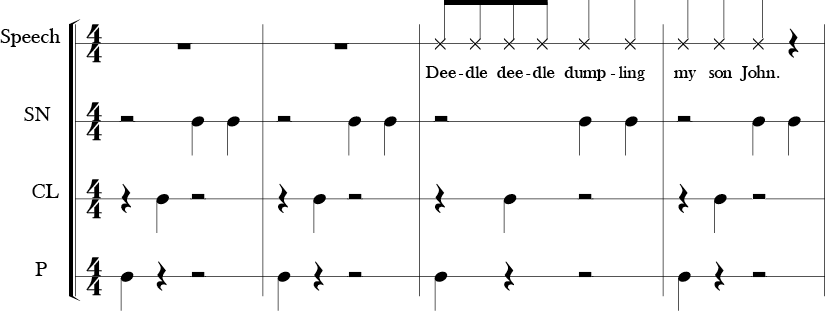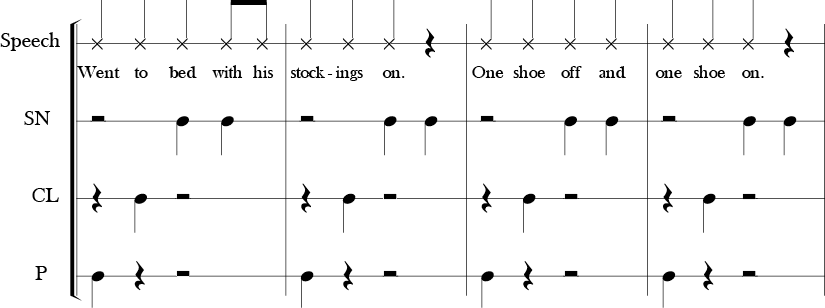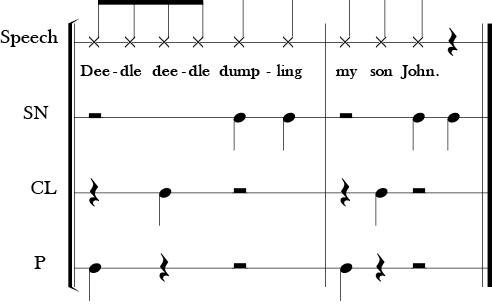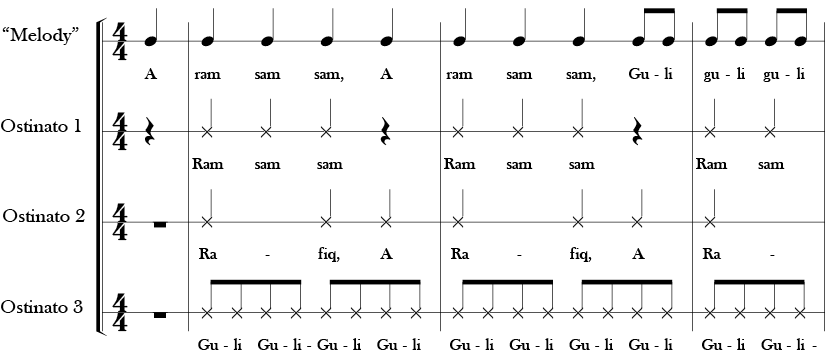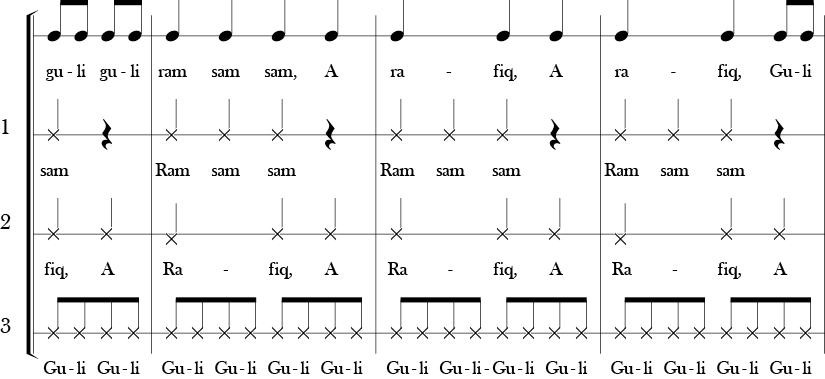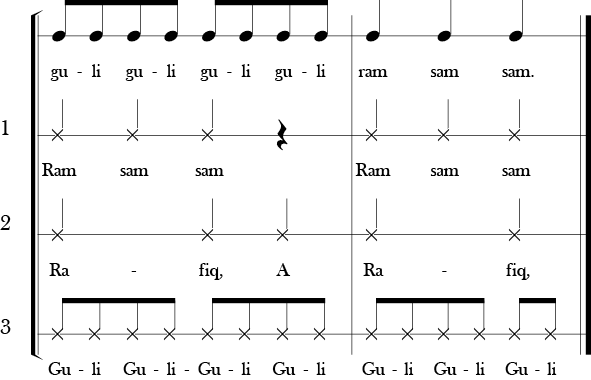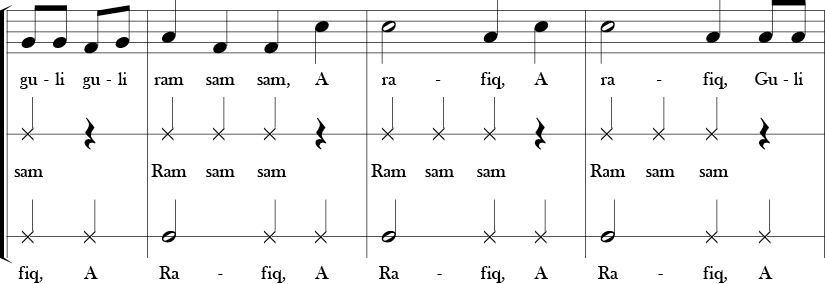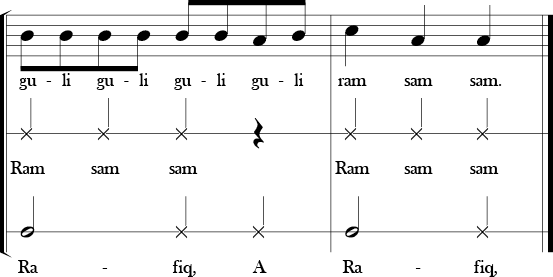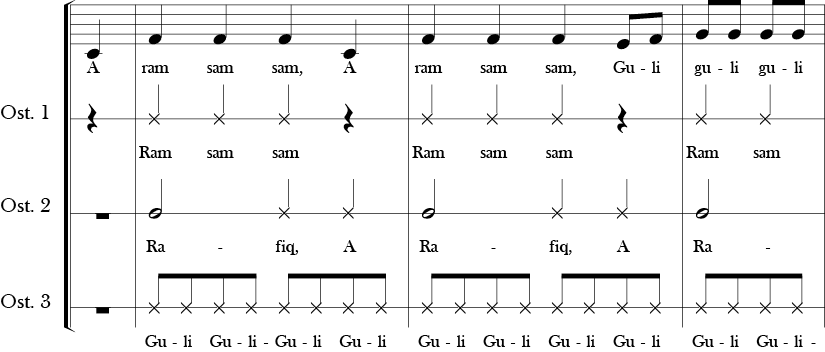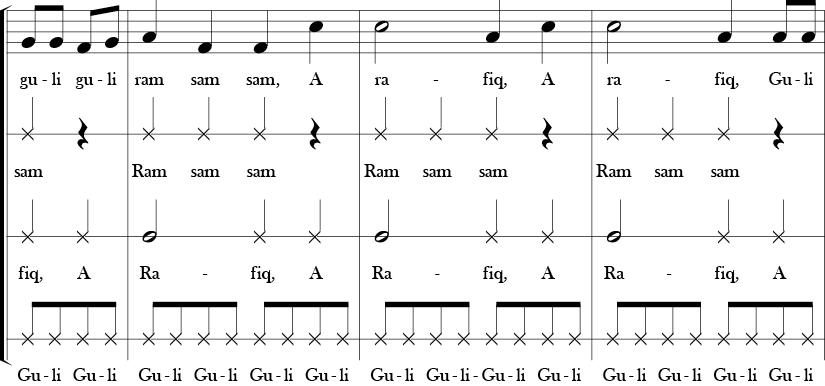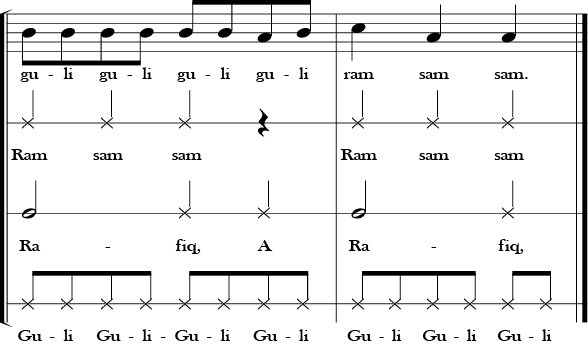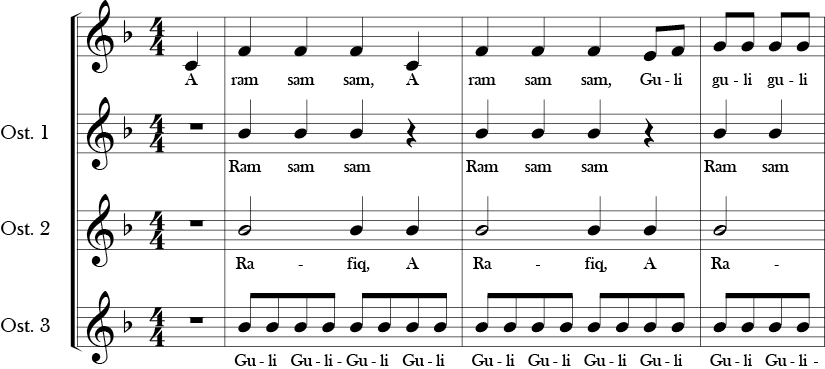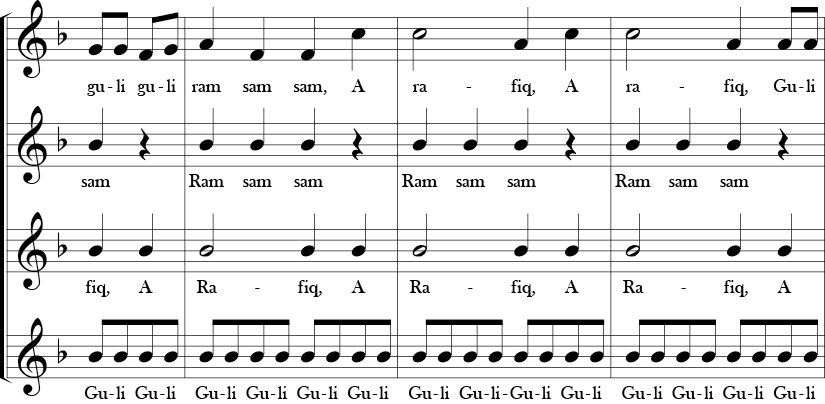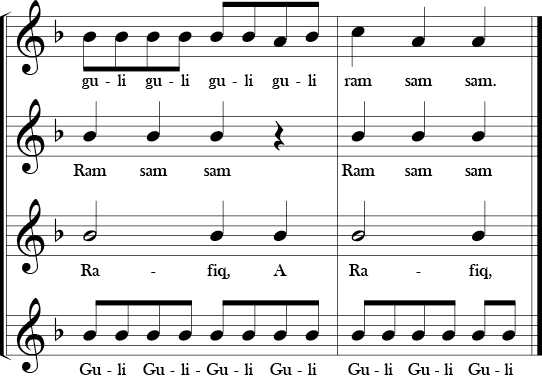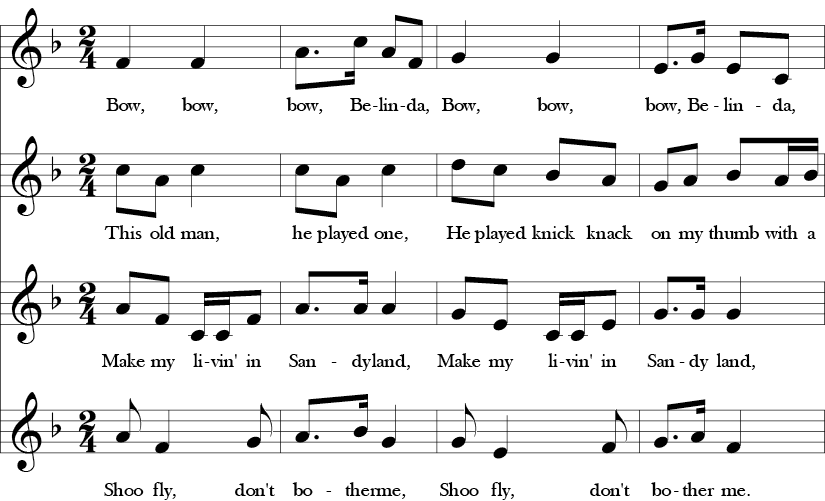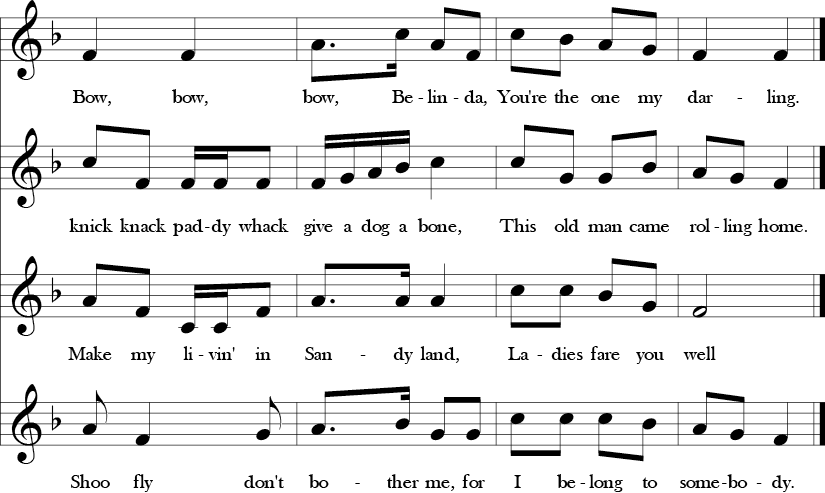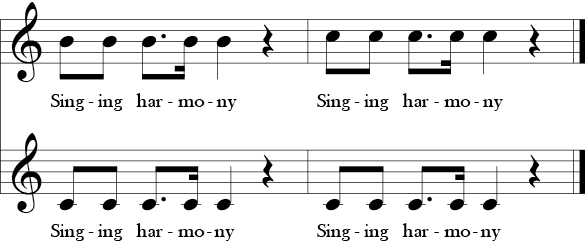Main Body
Chapter 9: Music and the Older Child
Chapter Summary: This chapter explores the uses of music with older elementary-aged children. It covers their vocal ranges, preparation for multi-part singing including echo songs, ostinato patterns, drone and multi-part performing including polyphony (multiple melodies) such as rounds, partner songs, harmony and descants, as well as other age-appropriate repertoire such as cumulative songs, play-party songs, and African-American songs.
Older children, ages 6 and up, have listened to a great deal of musical material in their short lives. The songs and sounds they’ve absorbed are part of western musical style, and are now part of the musical lingua franca or the music that is “normal” for them. They’re familiar with the musical genres, timbres, modes, and instruments, rhythmic and melodic patterns, and have learned the culturally acceptable cadences, harmonies, texture, and so forth. The lower to middle elementary-aged child is ready for more complex listening, singing, and music making. This chapter will offer music suggestions to inspire older children, including cultural games, songs, and dances.
I. Singing Voices of Older Children
Developmental Abilities
Just as children’s aptitude to learn a foreign language stabilizes after the age of 9, Music researcher Edwin Gordon (2007) found that children’s musical aptitude is also developmental, fluctuating until age 9, and stabilizing afterwards. This doesn’t mean that children can’t learn music after the age of 9, of course, but that the language of musical enculturation is well under way by that age. It is important to keep in mind that a rich musical environment at home and at school will greatly benefit a child’s musical and cognitive abilities at any age.
In terms of the voice, both boys and girls should remain singing in their head voice or falsetto. Falsetto is a light, high, head voice that is not pushed, yelled, or forced in any way. Younger boys can switch easily into falsetto or head voice, as their voices have not yet begun to change. A good falsetto produces a clear, clean “boy’s choir” type of sound, and is where children should try to sing in order to maintain a healthy voice.
Singing Ranges for Older Children
As we recall from the previous chapter, children’s singing ranges expand year by year. Older children may have an expanded vocal range, but it is important to remember that the pitches that are most comfortable to sing are in the middle of their range.
Six to Eight Years Old
Grades first through third, or six to eight-year-olds, can sing about an octave from C to C’, with their most comfortable notes from E to G.

Eight to Eleven Years Old
Children aged eight to eleven can sing from the B flat below middle C to about an E flat or E, 3 notes above high C’. Their most comfortable notes are between D and G.

Selecting a Song in the Proper Singing Range
When selecting a song for older children, first check the pitch range appropriate for the child given the guidelines above. Most of the notes of the song should match the child’s most comfortable pitches right in the middle of their range. Children start to become weaker when singing around middle C. Try to avoid songs that sit in a lower range such as middle C or D, and instead pitch or place the song slightly higher up around E, F and G. Most of the songs in this book are transposed to the key of F so that most of the pitches of the song are around the tonic, or F.
Another important thing to keep in mind is that where an adult feels most comfortable singing, is probably not where the child feels most comfortable. Remember that many times, classroom teachers pitch the song in their own range, not thinking about where the song would work best for the children, and children struggle to sing well.
Activity 9A
Try this
Select the notation below that best fits the vocal ranges for children ages 3, 4 and 5. How about 6-8? 8-11?
If You’re Happy and You Know It (Keys of E flat Major, C Major, F Major)
Eb Major
C Major
F Major
II. Advanced Musical Experiences
Beginning at around eight years of age, children are ready for more advanced musical experiences vocally, instrumentally, and theoretically, and more complex musical subject matter. This section will explore different types of songs appropriate for older children, and the process for introducing more complex musical experiences.
Repertoire
Most of us are surrounded by pop music culture, and children at this age are particularly aware of and influenced by the pop scene. They hear pop music, watch singing competition shows on television, have pop idols, and want to sing pop music. The challenge with older children is their desire to vocally imitate the pop singing style. This music, of course, is very familiar and accessible to them, and it is only normal that they are inspired by and want to mimic their favorite pop star. However, keep in mind that a child’s vocal apparatus is still developing, and imitating adult singing with scoops, chest voice, or belting is affected singing and not natural. Not only does it inhibit the child’s sense of ownership of their own vocal instrument and musicality, it also inhibits their ability to explore the natural timbre of their own voices, and find their own unique musical style. These songs are intended for adult voices, and are often out of the comfortable singing range of children. Belting or pushing a developing voice too far can be detrimental to the child’s voice, and can result in permanent damage.
Subject Matter
Luckily, there is an enormous children’s repertoire of songs, including folk songs, historical songs, play party songs, story and game songs, classical pieces, and popular songs written for children’s voices with subject matters that appeal to their developing sense of morality and worldview, and are steeped with sociohistorical meaning.
Many songs for older elementary children are highly appropriate for use in the classroom curriculum, including core subject songs (math, social studies, science), national songs, cultural and historical songs, language arts songs, holiday songs, etc. The songs presented in this book are folk and popular songs, some of which are not only historically important, but culturally significant as well. These songs are part of a potentially rich musical experience for the child—exposing them to material with inherent sociocultural meaning that can contribute to excellent lessons and, most importantly, enhance integration activities.
Multiple Part Performance: Introducing Texture and Layers
By the age of seven or eight, children are ready for some type of vocal multiple part performing. Multi-part performing includes both instrumental and vocal music making, and can refer to the performance of more than one melody at the same time (i.e. a round), vocal harmony, or any type of accompaniment. Playing two or more parts on instruments is far easier and children can begin this type of multi-part performance much earlier. Vocally, however, children find it quite difficult to sustain their own vocal part against that of another singer or singers before the age of 8.
Multi-part performance in either the vocal or instrumental milieu is cognitively beneficial, and will increase a child’s musical competence. Older children appreciate and are capable of singing complex songs, particularly those that include multiple parts and simple harmony. Musical texture (performing multiple lines of music simultaneously) not only creates more intricate and interesting music, but it provides significant cognitive benefits. Multi-part performance of any kind requires the child to focus intensely on their part, training the brain to produce one part while acknowledging additional auditory stimuli coming from the other parts. The brain then must process the whole piece at once while still remaining focused on the one performing part.
Children, who may not yet ready for harmony, can be prepped for harmony at much earlier ages through the use of layered speech pieces, rhythmic instrumental or vocal patterns (see ostinato below). Keep in mind that children are performing in multiple parts even when they are singing a song and doing any other simultaneous activity such as tapping the beat, playing a pattern on an instrument or performing body percussion (snapping, stomping). Any rhyme can be made more complex by adding a body percussion pattern or simple instrument pattern.
Deedle Deedle Dumpling
English nursery rhyme
Any familiar song can be used to teach two parts, such as taking a simple melody and adding a vocal ostinato. The song “A Ram Sam Sam,” for example, is a traditional Moroccan folk song that contains many simple repeating patterns. Begin by learning the song and performing it in unison. Then sing several times as a two part round.
A Ram Sam Sam
Traditional Morrocan folk round
Creating ostinati patterns
Ostinati are short patterns, repeated persistently throughout a piece often at the same pitch. Ostinati (pl. of ostinato) can be either vocal or rhythmic. The easiest way to find an ostinato is to take a short pattern right from the song itself. Ostinati can also be composed. Using short patterns from the song is a simple way to create vocal or rhythmic ostinati. Start by finding a short, simple, fun or interesting pattern in the song. An ostinato can be performed using body percussion, instruments or with the voice.
If the children are not ready to sing the song with a sung vocal ostinato, begin by chanting the song as a speech piece and adding one or more speech ostinato patterns.
A Ram Sam Sam (Speech with one ostinato)
Begin with a simple ostinato. In this case, the rhythm of the very last phrase “Ram Sam Sam” (ta ta ta rest), works very well. Have children clap and say the words simultaneously.

Two additional ostinati for this song with more complex rhythms include “ra-fiq a ra-fiq” (“ta-a ta, ta ta-a ta”) or “gu-li gu-li gu-li gu-li” (ti ti ti ti ti ti ti ti). Have children clap and say their ostinati. Notice, however, that “a ra-fiq” begins on a pickup beat, which can be tricky for entrances. To avoid that, begin with “ra” on the downbeat so that both ostinati (ra-fiq and gu-li gu-li) begin in simultaneously.


Divide the class into four equal parts, one group chanting and clapping the “melody” rhythm and the other three chanting and clapping the ostinati. After a few times through, have the students drop the chanting and perform the piece using clapping only.
A Ram Sam Sam (Speech with vocal ostinato)
Depending on the level of the class, the switch to singing the song with all of its ostinati can be done all at once or by using a combination of spoken and sung. Using a combined approach, begin by having the melody group sing the melody, while the ostinati groups come in one at a time using speech only.
A Ram Sam Sam (With one ostinato)
Gradually add the other two ostinati patterns, one at a time.
A Ram Sam Sam (With two ostinati)
A Ram Sam Sam (With three ostinati)
Move from using rhythmic ostinati to melodic ones. Be sure to have them learn the song very well before adding a sung ostinato. Divide the group in half and have half sing “Ram Sam Sam” while the other half sings the melody. These are examples of pitched ostinati that are taken directly from the melody of song (measures 2 and 9). The easier of the two is 1a, but if the class is advanced, use 1b.
Vocal Ostinato ex. 1a

Vocal Ostinato ex. 1b

The other two ostinati can also be sung. For more advanced groups, try dividing into three parts, with the melody in one part and sung ostinati in the other groups.
Vocal Ostinato #2

Vocal Ostinato #3

A Ram Sam Sam (With three sung ostinati)
Note: In order for the harmony to work with the song, the pitches for “gu-li gu-li” need to be changed in measures 3 and 7 to a “Bb” rather than “A.” If this is too difficult, remain on the “A.”
Drone
A drone is usually a single pitch, usually held or repeated underneath a melody. The simplest type of accompaniment is to add a single note drone to a melody. Songs such as “Amazing Grace,” “Bow, Wow, Wow,” “Tideo,” are all pentatonic songs that work well with a drone accompaniment. Drones can also be several pitches, but they repeat throughout all or most of a song. Children may be tempted to speak or chant the drone part, but it is important that they sing it, maintaining a constant pitch and good tone.
Tideo
Traditional American play party song
More complex part singing
Older children are ready for singing in two, three and four parts, and also performing on instruments layering many different patterns together. In singing, there are two types of basic part-singing appropriate for children: polyphony and harmony.
Polyphony is a word that refers to multiple independent lines of music sung at the same time. Polyphony can happen in many different ways. Rounds and partner songs are two good examples of polyphony.
In a round, all of the voices are singing the same melody but at slightly different times, and in a partner song each part is singing a different melody. The important element is that all of the parts or “voices” are equal, and there isn’t a single dominant melodic line. Although we associate rounds with children, there are many complex and lengthy rounds with more serious topics for adults.
Rounds
Rounds or canons have been around for hundreds of years, and play a significant role in European and American society. Group singing played a major role in society, for emotional expression, entertainment, social cohesion, and so forth. In a round, everyone contributes equally in terms of melody. The oldest polyphonic song known is the Medieval English song “Sumer Is Icumen In” dated from the mid-13th century. This round, which is about the arrival of summer, actually has two “melodic ostinati,” which are known as “grounds,” at the end, which can be sung along with the melody.
Sumer Is Icumin In
Medieval English song, 13th century
More simple rounds that most people know include: “Row, Row, Row Your Boat,” “Frère Jacques,” and “Scotland’s Burning.”
Row, Row, Row Your Boat
American folk song and round, 1852
Frère Jacques
French folk round, 18th century
Scotland’s Burning
Traditional American round, 19th century
More complex rounds include: “Oh How Lovely Is the Evening,” “Dona Nobis Pacem,” “Hey, Ho, Nobody Home,” which is in minor, and “Viva la Musica,” a 16th century round written by the Renaissance composer Giovanni Palestrina.
Oh, How Lovely
German folk round
Dona Nobis Pacem
Text from “Lamb of God,” Latin Mass
Hey Ho, Nobody Home
Chrismas round
Viva la Musica!
Michael Praetorius (1571-1621)
Partner songs
Partner songs are another way to experience multiple-part (polyphonic) singing. In a partner song, two or more songs, which are musically compatible, are sung together. Similar to a round, everyone contributes a melody. Partner songs are slightly more challenging to sing in that they use different melodies. A good example is the song “One Bottle of Pop” in which three separate melodies work well together.
One Bottle of Pop
Below are some additional examples of individual songs and their potential “partners” that blend well and go together. The songs “This Old Man,” “Skip to My Lou,” “Shoo Fly,” “Bow Belinda,” and “Sandy Land,” for example, are all able to be sung simultaneously.
This Old Man
English game song, 19th century
Skip to My Lou
Traditional American play party song
Shoo Fly
American folk song, 1863
Bow Belinda
Sandy Land
Traditional folk song, Texas
This Old Man and Sandy Land
Bow Belinda and This Old Man
All of the songs together:
Bow Belinda, This Old Man, Shoo Fly, Sandy Land
List of children’s songs and partner songs
The list below consists of suggested songs that work well when sung together. Each box represents a group of songs that can be sung in pairs as partner songs, or even layered as three or more songs.
Partner songs: groups of commonly known songs that can be paired or layered.
|
Row, Row, Row, Your Boat Here Comes a Bluebird Frere Jacques/Are you Sleeping? Three Blind Mice London Bridge The Old Grey Mare Mary Had a Little Lamb Merrily We Roll Along Boola, Boola The Farmer in the Dell Here We Go Looby Loo Go Tell Aunt Rhody Hot Cross Buns Where is Thumbkin? He’s Got the Whole World in His Hands Rock-a My Soul |
Bow Belinda Sandy Land This Old Man 10 Little Indians Skip to My Lou Paw, Paw Patch Mulberry Bush Oh, Dear, What Can the Matter Be? Irish Washerwoman Liza Jane Old Brass Wagon Michael Finnegan |
Good Night Ladies Pickalittle, Talkalittle (Music Man) When the Saints Go Marching In Swing Low Sweet Chariot This Train Nobody Knows the Trouble I’ve Seen Gospel Train She’ll be Comin’ Round the Mountain All Night, All Day Rock-a My Soul |
|
Joshua Fought the Battle of Jericho Hey Ho, Nobody Home When Johnny Comes Marching Home Wondrous Love Kookaburra Wade in the Water |
Juanita Santa Lucia Bicycle Built for Two Sidewalks of New York In the Good Old Summertime |
Arkansas Traveler Oh, Susanna Turkey in the Straw Camptown Races (verse) |
|
Humoresque Old Folks at Home Put on Your Old Gray Bonnet |
Child of God Mary Had a Baby Sing Hallelu |
One Bottle of Pop Don’t put your Dust Fish and Chips and Vinegar |
|
My Bonnie Lies Over the Ocean (refrain) Cielito Lindo (refrain) Man on the Flying Trapeze |
Home on the Range My Home’s in Montana |
Old Texas Old Chisholm Trail |
|
Ta-Ra-Ra-Boom-De-Ay Long, Long Ago |
All Night, All Day Swing Low Sweet Chariot |
I Love the Mountains Heart and Soul |
|
Bluetail Fly (refrain) Shoo Fly (refrain) |
Dixie Yankee Doodle |
Zum Gali Gali Shalom Chavarim |
|
I am a Poor Wayfaring Stranger Scarborough Fair |
Land of the Silver Birch My Paddle |
Be Bow Wow Wow Hot Cross Buns |
|
Sally Go Round the Sun See Saw, Margery Daw |
We Wish You a Merry Christmas O Christmas Tree |
Mango Walk Sweet Potatoes |
|
Lida Rose (Music Man) Will I Ever Tell You? |
Go Tell It on the Mountain Some Folks Do |
Mr. Frog Went A-Courtin’ Goin’ Down to Cairo |
|
Jubilate (Hark! The Vesper Bells are Ringing) Chumbara |
Haul Away Joe Early in the Morning |
Hush-a-bye Lullaby |
|
What Shall We Do with a Drunken Sailor Sinner Man |
Sing a Song of Peace This is My Country |
Little Red Caboose Sourwood Mountain |
Harmony
After success singing rounds and partner songs, children may be ready to sing in harmony. Harmony is the sounding of two notes simultaneously. When singing harmony, one voice usually has the melody and is dominant, while the harmony parts take a “back seat” so to speak. The melody notes are usually the highest notes, with the harmony supporting underneath. Singing in harmony is quite a bit more challenging than partner songs or rounds.
Harmony lines are often the interval of a third (3rd) or a sixth (6th) below the melody line. Singing a 3rd or 6th away from the melody is very challenging, as the tendency is for singers to slip from their parts into unison with the melody.
Preparation for vocal harmony
Singing a drone is excellent preparation for harmony (see “Tideo” above). Here is a scale warm-up that also helps prepare students to hold onto their part against another moving part.
Warm-up for Harmony
N. Sarrazin
Sarasponda
Attributed as a Dutch spinning song
Ah, Poor Bird (with harmony)
Elizabethan English round
Harmony N. Sarrazin
Descants are also a type of harmony, but are instead placed above the melody. Descants can have text, but are also sung on neutral syllables such as oh, or ah.
Ah, Poor Bird (with descant)
Elizabethan English round
Descant N. Sarrazin
III. American Children’s Games and Game Songs
America’s folk heritage is rich with songs from many cultures. Folk songs such as play party songs, African-American songs, story songs, and dance-songs are all a part of American music history and are excellent opportunities to discuss history and the role of music in our culture. The lyrics to these songs contain literary and social references, and are rife for inclusion in the interdisciplinary classroom. The songs can also fit into other aspects of children’s lives and their school curriculum as well.
Many game songs originated in the Georgia Sea Islands, a series of over 100 islands off the coast of South Carolina, Georgia, and Florida. The Islands have a long and complex cultural history, but are most known for their rich African-American heritage as white plantation owners left the islands in the 19th century leaving their slaves behind. The result was the creation of a distinct Gullah/Creole language and culture, which can be found in many children’s games.
Draw Me a Bucket of Water
Georgia Sea Islands singing game
Groups of four: Couples facing each other grab both hands and sway back and forth to the beat while singing. The inside of the circle represents the “bucket.” As the numbers increase, a person is added to the bucket encircled by the clasped hands.
Ridin’ in a Buggy
Traditional American play party song, South Carolina
Oh! Susanna
American minstrel song
Stephen Foster, 1848
Doctor Knickerbocker
American game song
Here We Go Zudio
African American song
Play Party Games
Play parties are singing parties that evolved along with the rural frontier American experience. In the early 1800s in the southwestern and western states, there was a prohibition against playing musical instruments and dancing by certain religious organizations. Play parties were a way around this. They were a social activity in which young people sang songs while clapping, incorporating drama, and some swinging movements. Many songs we know such were play-party songs such as “Buffalo Gals,” “Skip to my Lou,” “Old Dan Tucker,” “Old Brass Wagon,” “Pop Goes the Weasel,” “Weevily Wheat,” and “B.I.N.G.O.”
The movements to “Old Brass Wagon” have children in a circle, basically following the instructions in the song. Everyone holds hands and circles to the left on the first verse, right on the second, etc.
Old Brass Wagon
Traditional American play party song
The circle dance song “I’ve Been to Haarlem” requires a more sophisticated choreography. One child stands in the middle of a circle of partners who walk in a circle in promenade position. On the words “turn the glasses over,” the partner on the outside of the circle turns under the inside partner’s arms, thus changing direction. The partners let go, and circle in opposite directions until the words “lose your partner in the ocean.” On this last word “ocean” the child in the middle quickly rushes around trying to find a partner and leaving one child “out” who is now the one in the middle.
I’ve Been to Haarlem
The song “Weevily Wheat” refers to wheat that is infested with beetles or weevils that destroy the plants. The game for “Weevily Wheat” requires children in small groups of four, with each child numbering off 1-2-3-4. The song begins with the children holding hands and moving clockwise. On “take some,” everyone reverses direction. On the words “five times five” all stand in place and layer hands in the center of the circle to the beat of the song. Child 1 puts their left hand in, 2 put theirs on top, 3 and 4 continue the pattern. Then all layer their right hand in. When they run out of hands, the children pull their left hand out from the bottom of the pile in turn and place on top, continuing until the end of the verse. This song contains multiplication and can be used as an extension activity for math.
Weevily Wheat
Traditional American play party song
Cumulative Songs
Cumulative songs are those in which each verse adds on lyrics and music from the previous verse, and by the end of the song, the singer sings through all of the accumulated lyrics. The most well-known cumulative song is “The Twelve Days of Christmas,” but there are many others. These songs provide an excellent cognitive workout, as the singer has to mentally catalog each verse, adding each verse as they progress through the song, but then singing all of the lyrics backward in a cumulative fashion.
Some examples of cumulative songs are “Hey Ho, the Rattlin’ Bog,” “There was an Old Lady who Swallowed a Fly,” “The Green Grass Grew all Around,” “Allouette,” and “I Bought me a Cat.”
The song “Rattlin’ Bog” has a refrain with verses that accumulate. This Irish song is also meant to gradually speed up in tempo as you sing.
Activity 9B
Listen
Listen to the band Irish Descendants sing “Rattlin’ Bog.” What is your reaction to the tempo of the song? Are you able to sing along? How might you use this type of song in a lesson?
The Rattlin’ Bog
Traditional Irish folk song
“I Bought Me a Cat” is a traditional American song arranged by the famous American composer Aaron Copland. This song does not have a refrain, but the verses themselves accumulate lyrics.
I Bought Me a Cat
Traditional American children’s song
I bought me a pig, my pig pleased me
I fed my pig under yonder tree,
My pig says “griffey, griffey”
My hen says “shimmey shack, shimmey shack”
My goose says “quaw, quaw”
My duck says, “quaa, quaa”
My cat says “fiddle-i-fee.”
I bought me a cow, my cow pleased me
I fed my cow under yonder tree,
My cow says “baw, baw” (etc.)
I bought me a horse, my horse pleased me
I fed my horse under yonder tree,
My horse says “neigh, neigh” (etc.)
I got me a wife, my wife pleased me
I fed my wife under yonder tree,
My wife says “honey, honey” (etc.)
Songs Every Child Should Know
National Association for Music Educators (NAfME) (formerly known as Music Educators National Conference, MENC) developed a suggested list of 42 songs every child should know. The songs are culled from folk, stage musicals, patriotic songs, Tin Pan Alley songs, culturally diverse songs, film songs, and religious songs.
42 Songs Every Child Should Know
- Amazing Grace
- America
- America the Beautiful
- Battle Hymn of the Republic
- Blue Skies
- De Colores
- Danny Boy (Londonderry Air)
- Dona Nobis Pacem
- Do-Re-Mi
- Down by the Riverside
- Frere Jacques
- Give My Regards to Broadway
- God Bless America
- God Bless the U.S.A.
- Green, Green Grass of Home
- Havah Nagilah
- He’s Got the Whole World In His Hands
- Home on the Range
- I’ve Been Working on the Railroad
- If I Had a Hammer (The Hammer Song)
- Let There Be Peace on Earth
- Lift Ev’ry Voice and Sing
- Michael Row the Boat Ashore
- Music Alone Shall Live
- My Bonnie Lies Over the Ocean
- Oh, What a Beautiful Mornin’
- Oh! Susanna
- Over My Head
- Puff the Magic Dragon
- Rock-A-My Soul
- Sakura
- Shalom Chaverim
- She’ll Be Comin’ Round the Mountain
- Shenandoah
- Simple Gifts
- Sometimes I Feel Like a Motherless Child
- Star Spangled Banner
- Swing Low, Sweet Chariot
- This Land Is Your Land
- This Little Light of Mine
- Yesterday
- Zip-A-Dee-Doo-Dah
Resources
Songs for Teaching http://www.songsforteaching.com/index.html
- An excellent resource that includes educational songs, mathematics, social studies, plus classroom transition songs, activity and game songs, and much more.
Music Educator http://digitalmusiceducator.wordpress.com/2010/02/08/15-resources-for-elementary-music-teachers/
- Contains 15 websites for music.
Kodály Song Web http://kodalysongweb.net/songs
- A database of hundreds of songs categorized to indicate appropriate age, meter, genre, origin, melodic and rhythmic elements.
Music Notes http://musicnotes.net/songs_ALPHA.html
- Alphabetical list of hundreds of songs classified by grade, keywords for connecting to other subject areas and musical elements (meter, form, pitches). Also contains pitch and rhythm warm-ups, recorder, and sheet music.
Mama Lisa’s World, International Music and Culture http://www.mamalisa.com/?t=hes&p=1299
- Contains hundreds of songs and rhymes by country of origin, as well as English nursery rhymes, Mother Goose, children’s poetry, a blog and book reviews.
National Institute of Environmental Health Science (NIEHS) Kid’s Page http://kids.niehs.nih.gov/games/songs/index.htm
- Hundreds of children’s song lyrics with audio files for listening. Includes educational children’s songs, holiday songs, favorites, and songs for teaching English as a second language.
References
Gordon, E. E. (2007). Learning sequences in music: A contemporary music learning theory. Chicago, IL: GIA.
Vocabulary
cumulative songs: songs in which each verse adds on lyrics and music from the previous verse; by the end of the song the singer is singing through all of the accumulated lyrics
descants: a type of harmony that is placed above the melody; can have text, but can also be sung on neutral syllables such as “oh,” or “ah”
falsetto: a light, high, head voice that is not pushed, yelled, or forced in any way; usually used by boys
harmony: sounding of two or more notes simultaneously
partner songs: two songs, which are musically compatible, are sung together, and everyone contributes to the melody; considered more challenging than rounds.
polyphony: refers to multiple independent lines of music sing at the same time
rounds: also known as canons; group singing in which everyone contributes equally in terms of their melody
ostinato (pl. ostinati): easily repeated short musical phrases, patterns, or fragments.
unison: all parts are the same and sung at the same time













